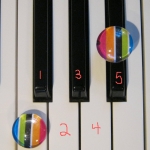No Transposing Needed! Free Prelude!
Are you a church pianist that doesn’t know how to transpose? Do you choose hymns for prelude that are in the same key for this very reason? I have good news for you!
It is not always necessary to transpose from one song to the next if you go up a perfect fourth between each hymn. I’m providing a free prelude below but read the important info below before you hurry to print the free prelude.
~ ~ ~ ~ ~ ~ ~ ~ ~
Going Up a Perfect 4th Interval From One Hymn to the Next Hymn:
What You Need to Know:
1. An interval is the distance between two notes
Example:
C to D is a 2nd interval because you count from 1 t0 2 to go from C to D.
C to E would be a 3rd interval and C to F a fourth.
2. Within every key/scale… the fourth interval is called a perfect fourth which consists of five half steps. So… from C to F is a perfect fourth. Why is it called a perfect fourth? Just accept it and go on or if you’re curious…check out the following links 🙂
Quick quiz in Creating Perfect Fourths:
What is 5 half steps (a perfect 4th) above F? Answer is: B flat (see picture below)
(Are you noticing that we’re going in order of the flat keys as we go up a 4th?)
The key of F Major has one flat, the key of B Flat Major has two flats. Cool!
Ok….so what is 5 half steps (a perfect fourth)… above B flat? You got it! E flat and the key of E flat has three flats.
Now…let’s apply this “no transposing” concept using the following hymns which are a perfect fourth apart for a nice topical prelude!
Click on each song title to download for FREE!
Free Prelude for Church Pianists:
Since I Have Been Redeemed – F Major
Power in the Blood – B Flat Major
Saved by the Blood – E Flat Major
*All of these arrangements are from our free arrangement page(s)
Tags: church pianist, free prelude, no transposition needed, perfect fourth, transposing, transposing hymns


I knew how to do this by a Rudy Atwood arrangement, but never knew the theory behind it. I know in the arrangement, Mr. Atwood went from C to F and then to Bflat so I do know that I can go up two flats (down two sharps). He ended in the key of C, and his right hand went down to B and then Bflat, then G, and when going back up to A, his left hand went to the F cord. Right hand continuing down to G, F and then Eflat got you to Bflat major. I absolutely know you would know that, but maybe some of your readers might be interested in that little info. You could explain it better. I go from decreasing sharps, down to C and back up to the increasing flats. I just recently went back and reviewed your transposing of (example) – F to G and used that at a funeral with Amazing Grace. I had the hymn in those two keys and last verse went from F to G. Thanks for taking time to teach!
Yep 🙂 Article worthy information for sure….just kept the above info relative to the article title and was going to share the 7th chord way in another article.
Thanks for your feedback! Exciting to hear your of your transposing application on Amazing Grace!